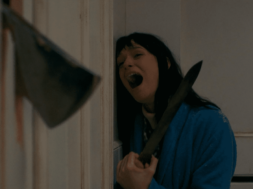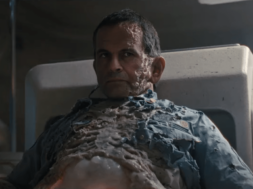When it comes to race and “uncomfortable conversations,” Nia DaCosta is out of fucks to give. Before most of us hit grade school, we’re taught to fear the boogeyman and other things that go bump in the night, but DaCosta violently disagrees. For her, the scariest things are the trauma, cultural appropriation, and lack of compassion that make Black legends like Candyman necessary in the first place. DaCosta’s vision of Candyman picks apart the myth and the events leading to its creation, arguing that the true horror isn’t saying his name five times in the mirror.
Candyman focuses on generational tragedy and trauma. Rather than making him just a housing projects boogeyman, the 2021 model frames him as an unfortunately upheld legacy. Daniel Robitaille’s story is an American story. There are countless Black bodies in unmarked graves for being in the wrong place at the wrong time or because they “fit the description.” We know about George Floyd, Travyon Martin, Tamir Rice, and Elijah McClain. But any person with melanin will tell you their deaths, while tragic, aren’t new developments.
When mothers and fathers cry on television, we get it. When people march and demonstrate, we feel it. But Candyman effectively captures the numbness to that pain. Anthony McCoy, Brianna Cartwright, William Buckley, and every Black character in the movie know trauma will always loom over them like a shadow. The original never sought to put that type of pain on screen because it’s kind of hard to do.
Well, almost.
DaCosta understands it, as do her actors. With everyone on the same page, it’s easier to illustrate those feelings to an audience—even the ones sitting in cheap seats.
Going that route puts the sequel in a semi-heated discussion with the original. If there’s one thing that makes you go “hmm” in the first flick, it’s that a Black man, who was lynched and disarmed by white slave owners, stalks people who look like him. Rather than explain the contradiction, DaCosta and Jordan Peele finish a sentence that previously ended with an ellipsis in 1992. By tying Candyman to current events, DaCosta positions him as an antihero for the Black community. No equivocation, no half measures, and no apologies given. We are no longer his victims, and in fact, the mere thought that he might be real may save us.
Burke’s reasoning for creating a new Candyman is sound. Sure, he’s crazy, but that doesn’t mean he isn’t right. Candyman equals violence, and violence keeps developers away. Places like Cabrini Green are intentionally starved of resources and opportunities, only to magically get rebuilt in a more expensive image when the Black residents are forced out. There’s a reason Burke’s business is flanked on both sides by two fancier startups. They’re nondescript, devoid of character, and dull as fuck. He’s doing all he can to survive while the neighborhood he grew up in and helped build is now doing its best to swallow him whole. The movie says that a national story about a “crazy” white woman terrorizing the projects made that process easy.
The idea of a scary Black man haunting the land keeps people away because it says the place isn’t safe. No matter how gentrified cities get, there are always neighborhoods or blocks seemingly immune. Dollars to donuts, those areas are plagued with the most crime or filled with Black people. Or both.
To that point, the most violent act in the film, one that exacerbates trauma and underlines gentrification, is appropriation. A friend recently told me it’s easy to spot who truly knows Hip Hop culture and who is merely just visiting. Apply that to Black culture as a whole, and that’s where Candyman sharpens its blade. The victims—who just so happen to be white—seek to exploit Black culture, profit from it, or don’t respect it. The curator and his intern/girlfriend/booty call use the Candyman ritual as a kinky sex game (shoutout to Hellraiser). The art critic only cares about Anthony’s work when she sees pain and blood with it. And the white high school girls think saying “Candyman” five times is something to trifle with for kicks and giggles.
The curator and the critic have conversations any Black creative can relate to all too well. They want the drama. They crave the struggle. And they feed off the idea they found Neo in the Matrix, one who can rise out the community while they pat themselves on the back and say, “I did that.” They don’t see us; they see dollar signs. And that limited vision hinders their ability to empathize or do anything but slap a sale sign on our pain. It’s easy to see this as Nia and Jordan commenting on the slew of properties post-Get Out, who missed the point entirely. Studios saw a trend and sought to capitalize without understanding because that’s what Hollywood does. But it felt worse because these were stories about us reinforcing the same tired narrative. Ironically, that’s something Anthony initially fights against until he has no choice but to give in.
Most of our stories told by white people or historically cherished by white audiences involve our suffering. No one cared about Anthony’s work until it dove into Cabrini Green or until there were actual murders attached to it. Even Brianna, who is very successful, only gets into rooms to have conversations to advance her career because of her boyfriend’s tribulations. How do you walk around knowing your pain is someone else’s entertainment and not go insane? William understood this long before Anthony and Brianna, so maybe that’s why he was a tad bit off of his rocker. But in a world that built the projects, moved his people out of them, exploited them for all they’re worth, can you blame him?
Those high school girls didn’t die because they said Candyman five times in a mirror. They turned into piles of entrails because they played with something they didn’t understand, thinking it would be cool. Visiting Black culture with no respect for its origins isn’t a good look. In the world of Candyman, it gets you killed. His victims committed one micro-aggression too many and paid the consequences. In that context, of course, Candyman is now an avenger of Black people and injustice.
The most horrifying thing about the movie is how easy gentrification and appropriation are. The perpetrators don’t respect what came before them, so none of it matters. Nor do they care for the Black bodies who toiled to create the business, artwork, or the stories passed down from one generation to the next. As he says while slicing and dicing crooked cops, the world will say he slaughters innocents. But not a single victim in Candyman is innocent, whether they believe it or not.
What’s scarier: saying the name of a boogeyman in a mirror five times or the conditions that led to the creation of said boogeyman? Until we all have the same answer and can speak in one voice, expect more Candymen in our future. Tell everyone.












